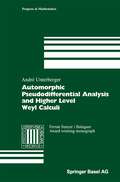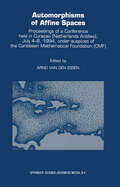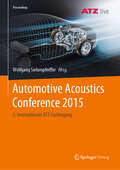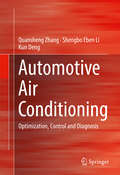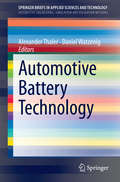- Table View
- List View
Automorphic Pseudodifferential Analysis and Higher Level Weyl Calculi (Progress in Mathematics #209)
by André UnterbergerAutomorphic Representation of Unitary Groups in Three Variables. (AM-123), Volume 123 (PDF)
by Jonathan David RogawskiThe purpose of this book is to develop the stable trace formula for unitary groups in three variables. The stable trace formula is then applied to obtain a classification of automorphic representations. This work represents the first case in which the stable trace formula has been worked out beyond the case of SL (2) and related groups. Many phenomena which will appear in the general case present themselves already for these unitary groups.
Automorphism Groups of Compact Bordered Klein Surfaces: A Combinatorial Approach (Lecture Notes in Mathematics #1439)
by Emilio Bujalance Jose J. Etayo Jose M. Gamboa Grzegorz GromadzkiThis research monograph provides a self-contained approach to the problem of determining the conditions under which a compact bordered Klein surface S and a finite group G exist, such that G acts as a group of automorphisms in S. The cases dealt with here take G cyclic, abelian, nilpotent or supersoluble and S hyperelliptic or with connected boundary. No advanced knowledge of group theory or hyperbolic geometry is required and three introductory chapters provide as much background as necessary on non-euclidean crystallographic groups. The graduate reader thus finds here an easy access to current research in this area as well as several new results obtained by means of the same unified approach.
Automorphisms and Derivations of Associative Rings (Mathematics and its Applications #69)
by V. KharchenkoAutomorphisms in Birational and Affine Geometry: Levico Terme, Italy, October 2012 (Springer Proceedings in Mathematics & Statistics #79)
by Ivan Cheltsov Ciro Ciliberto Hubert Flenner James McKernan Yuri G. Prokhorov Mikhail ZaidenbergThe main focus of this volume is on the problem of describing the automorphism groups of affine and projective varieties, a classical subject in algebraic geometry where, in both cases, the automorphism group is often infinite dimensional. The collection covers a wide range of topics and is intended for researchers in the fields of classical algebraic geometry and birational geometry (Cremona groups) as well as affine geometry with an emphasis on algebraic group actions and automorphism groups. It presents original research and surveys and provides a valuable overview of the current state of the art in these topics.Bringing together specialists from projective, birational algebraic geometry and affine and complex algebraic geometry, including Mori theory and algebraic group actions, this book is the result of ensuing talks and discussions from the conference “Groups of Automorphisms in Birational and Affine Geometry” held in October 2012, at the CIRM, Levico Terme, Italy. The talks at the conference highlighted the close connections between the above-mentioned areas and promoted the exchange of knowledge and methods from adjacent fields.
Automorphisms of Affine Spaces
by Arno Van Den EssenAutomorphisms of Affine Spaces describes the latest results concerning several conjectures related to polynomial automorphisms: the Jacobian, real Jacobian, Markus-Yamabe, Linearization and tame generators conjectures. Group actions and dynamical systems play a dominant role. Several contributions are of an expository nature, containing the latest results obtained by the leaders in the field. The book also contains a concise introduction to the subject of invertible polynomial maps which formed the basis of seven lectures given by the editor prior to the main conference. Audience: A good introduction for graduate students and research mathematicians interested in invertible polynomial maps.
Automorphisms of Finite Groups (Springer Monographs in Mathematics)
by Inder Bir Passi Mahender Singh Manoj Kumar YadavThe book describes developments on some well-known problems regarding the relationship between orders of finite groups and that of their automorphism groups. It is broadly divided into three parts: the first part offers an exposition of the fundamental exact sequence of Wells that relates automorphisms, derivations and cohomology of groups, along with some interesting applications of the sequence. The second part offers an account of important developments on a conjecture that a finite group has at least a prescribed number of automorphisms if the order of the group is sufficiently large. A non-abelian group of prime-power order is said to have divisibility property if its order divides that of its automorphism group. The final part of the book discusses the literature on divisibility property of groups culminating in the existence of groups without this property. Unifying various ideas developed over the years, this largely self-contained book includes results that are either proved or with complete references provided. It is aimed at researchers working in group theory, in particular, graduate students in algebra.
Automotive A-Z: Lane’s complete dictionary of automotive terms
by Keith LaneThe most comprehensive guide to automotive terms available. Whether you're a student, apprentice, mechanic, automative industry worker, a driver, or car/motorcycle enthusiasts, with over 13,000 entries and extensive appendices, this guide explains the function of thousands of car, truck and motorcycle components.â ¢ Contains an English/American translator, with 350 automotive terms.â ¢ Defines the meanings of automotive acronyms like ABS, PS, CPU and VIN.
Automotive Accident Reconstruction: Practices and Principles, Second Edition
by Donald E. Struble John D. StrubleThis fully updated edition presents practices and principles applicable for the reconstruction of automobile and commercial truck crashes. Like the First Edition, it starts at the very beginning with fundamental principles, information sources, and data gathering and inspection techniques for accident scenes and vehicles. It goes on to show how to analyze photographs and crash test data. The book presents tire fundamentals and shows how to use them in spreadsheet-based reverse trajectory analysis. Such methods are also applied to reconstructing rollover crashes. Impacts with narrow fixed objects are discussed. Impact mechanics, structural dynamics, and conservation-based reconstruction methods are presented. The book contains a comprehensive treatment of crush energy and how to develop structural stiffness properties from crash test data. Computer simulations are reviewed and discussed. Extensively revised, this edition contains new material on side pole impacts. It has entirely new chapters devoted to low-speed impacts, downloading electronic data from vehicles, deriving structural stiffness in side impacts, and incorporating electronic data into accident reconstructions
Automotive Accident Reconstruction: Practices and Principles, Second Edition
by Donald E. Struble John D. StrubleThis fully updated edition presents practices and principles applicable for the reconstruction of automobile and commercial truck crashes. Like the First Edition, it starts at the very beginning with fundamental principles, information sources, and data gathering and inspection techniques for accident scenes and vehicles. It goes on to show how to analyze photographs and crash test data. The book presents tire fundamentals and shows how to use them in spreadsheet-based reverse trajectory analysis. Such methods are also applied to reconstructing rollover crashes. Impacts with narrow fixed objects are discussed. Impact mechanics, structural dynamics, and conservation-based reconstruction methods are presented. The book contains a comprehensive treatment of crush energy and how to develop structural stiffness properties from crash test data. Computer simulations are reviewed and discussed. Extensively revised, this edition contains new material on side pole impacts. It has entirely new chapters devoted to low-speed impacts, downloading electronic data from vehicles, deriving structural stiffness in side impacts, and incorporating electronic data into accident reconstructions
Automotive Acoustics Conference 2015: 3. Internationale ATZ-Fachtagung (Proceedings)
Elektrofahrzeuge sind für Entwickler der Fahrzeugakustik ebenso eine Herausforderung wie eine höhere NVH-Performance durch Leichtbaustrukturen und kleinere Motoren mit Turbolader. Die Automobilforschung muss das Akustikmanagement im Fahrzeug neu denken. Die internationale Automotive Acoustics Conference bietet dazu als Fachtagung das notwendige Expertenwissen, um die künftigen Anforderungen an Antriebsstrang, Antriebssysteme und Fahrzeugarchitekturen zu erfüllen. Simulationsprozesse und Verfahren der Multiphysik sind dabei essenziell, um Ruhe in die Passagierkabine zu bringen. Die Konferenz zur car acoustics bietet dazu neustes Expertenwissen.
Automotive Acoustics Conference 2017: 4. Internationale ATZ-Fachtagung Fahrzeugakustik (Proceedings)
by Wolfgang SiebenpfeifferTechnische Akustik und NVH gehören zu den wichtigsten Indikatoren für Fahrzeugqualität und -verarbeitung. Mit den grundlegenden Veränderungen der Antriebstechnik rücken diese Aspekte daher zunehmend in den Fokus der Automobilforschung und -entwicklung. Fahrzeugarchitekturen, Antriebssysteme und Designgrundsätze werden weltweit wegen der Emissionsgesetzgebungen, die energieeffiziente Fahrzeuge fördern, einer kritischen Betrachtung unterzogen. Schon in sehr naher Zukunft wird die gleiche oder eine höhere NVH-Performance durch Leichtbaustrukturen, kleinere Motoren mit Turbolader oder auch alternative Antriebsstränge erreicht werden müssen. Die internationale Automotive Acoustics Conference bietet hierbei ein wichtiges globales Forum für den Informationsaustausch.
Automotive Acoustics Conference 2019: 5. Internationale ATZ-Fachtagung Fahrzeugakustik (Proceedings)
by Wolfgang SiebenpfeifferDer Tagungsband zur ATZlive-Veranstaltung „Automotive Acoustics Conference 2019“ befasst sich mit technischer Akustik und NVH, welche zu den wichtigsten Indikatoren für Fahrzeugqualität und -verarbeitung gehören. Mit den grundlegenden Veränderungen der Antriebstechnik rücken diese Aspekte daher zunehmend in den Fokus der Automobilforschung und -entwicklung. Fahrzeugarchitekturen, Antriebssysteme und Designgrundsätze werden aufgrund der weltweiten Emissionsgesetzgebungen, die energieeffiziente Fahrzeuge fördern, einer kritischen Betrachtung unterzogen. Schon in sehr naher Zukunft muss die gleiche oder eine höhere NVH-Performance durch Leichtbaustrukturen, kleinere Motoren mit Turbolader oder alternative Antriebsstränge erreicht werden. Die internationale Automotive Acoustics Conference bietet hierfür ein wichtiges globales Forum für den Wissens- und Meinungsaustausch.
Automotive Acoustics Conference 2021: 6. Internationale ATZ-Fachtagung Fahrzeugakustik (Proceedings)
by Alexander HeintzelDer Tagungsband zur ATZlive-Veranstaltung „Automotive Acoustics Conference 2021“ befasst sich mit technischer Akustik und NVH, welche zu den wichtigsten Indikatoren für Fahrzeugqualität und -verarbeitung gehören. Mit den grundlegenden Veränderungen der Antriebstechnik rücken diese Aspekte daher zunehmend in den Fokus der Automobilforschung und -entwicklung. Fahrzeugarchitekturen, Antriebssysteme und Designgrundsätze werden aufgrund der weltweiten Emissionsgesetzgebungen, die energieeffiziente Fahrzeuge fördern, einer kritischen Betrachtung unterzogen. Schon in sehr naher Zukunft muss die gleiche oder eine höhere NVH-Performance durch Leichtbaustrukturen, kleinere Motoren mit Turbolader oder alternative Antriebsstränge erreicht werden. Die internationale Automotive Acoustics Conference bietet hierfür ein wichtiges globales Forum für den Wissens- und Meinungsaustausch.
Automotive Aerodynamics (Automotive Series)
by Joseph KatzThe automobile is an icon of modern technology because it includes most aspects of modern engineering, and it offers an exciting approach to engineering education. Of course there are many existing books on introductory fluid/aero dynamics but the majority of these are too long, focussed on aerospace and don’t adequately cover the basics. Therefore, there is room and a need for a concise, introductory textbook in this area. Automotive Aerodynamics fulfils this need and is an introductory textbook intended as a first course in the complex field of aero/fluid mechanics for engineering students. It introduces basic concepts and fluid properties, and covers fluid dynamic equations. Examples of automotive aerodynamics are included and the principles of computational fluid dynamics are introduced. This text also includes topics such as aeroacoustics and heat transfer which are important to engineering students and are closely related to the main topic of aero/fluid mechanics. This textbook contains complex mathematics, which not only serve as the foundation for future studies but also provide a road map for the present text. As the chapters evolve, focus is placed on more applicable examples, which can be solved in class using elementary algebra. The approach taken is designed to make the mathematics more approachable and easier to understand. Key features: Concise textbook which provides an introduction to fluid mechanics and aerodynamics, with automotive applications Written by a leading author in the field who has experience working with motor sports teams in industry Explains basic concepts and equations before progressing to cover more advanced topics Covers internal and external flows for automotive applications Covers emerging areas of aeroacoustics and heat transfer Automotive Aerodynamics is a must-have textbook for undergraduate and graduate students in automotive and mechanical engineering, and is also a concise reference for engineers in industry.
Automotive Aerodynamics (Automotive Series)
by Joseph KatzThe automobile is an icon of modern technology because it includes most aspects of modern engineering, and it offers an exciting approach to engineering education. Of course there are many existing books on introductory fluid/aero dynamics but the majority of these are too long, focussed on aerospace and don’t adequately cover the basics. Therefore, there is room and a need for a concise, introductory textbook in this area. Automotive Aerodynamics fulfils this need and is an introductory textbook intended as a first course in the complex field of aero/fluid mechanics for engineering students. It introduces basic concepts and fluid properties, and covers fluid dynamic equations. Examples of automotive aerodynamics are included and the principles of computational fluid dynamics are introduced. This text also includes topics such as aeroacoustics and heat transfer which are important to engineering students and are closely related to the main topic of aero/fluid mechanics. This textbook contains complex mathematics, which not only serve as the foundation for future studies but also provide a road map for the present text. As the chapters evolve, focus is placed on more applicable examples, which can be solved in class using elementary algebra. The approach taken is designed to make the mathematics more approachable and easier to understand. Key features: Concise textbook which provides an introduction to fluid mechanics and aerodynamics, with automotive applications Written by a leading author in the field who has experience working with motor sports teams in industry Explains basic concepts and equations before progressing to cover more advanced topics Covers internal and external flows for automotive applications Covers emerging areas of aeroacoustics and heat transfer Automotive Aerodynamics is a must-have textbook for undergraduate and graduate students in automotive and mechanical engineering, and is also a concise reference for engineers in industry.
Automotive Aftermarket: Global and Interdisciplinary Perspectives (Management for Professionals)
by Maria Elo Fotios KatsardisThe automotive aftermarket is a part of the global value network that involves manufacturing, trading, distributing and developing goods and services to global and local automotive markets. Sustainable mobility and automobiles, from passenger cars to heavy-duty vehicles, are existentially linked to transforming systems and multiple stakeholders across their life-cycles. Through diverse perspectives, this book reveals relevant trends and data, while shedding light on managerial aspects, circularity, institutions, operational linkages, and emerging challenges shaping future mobility. Further, it connects discussions on automotive aftermarket with global consumption of mobility, its sustainability, technology, sectoral knowledge, talent dynamics and relevant actors. The chapters offer global and interdisciplinary viewpoints, including theoretical and practical perspectives alike, of the under-researched automotive aftermarket. The sector represents a major source of revenues in the overall automotive industry contributing to functioning societies. The authors illustrate ongoing transformations of the global aftermarket addressing different challenges and opportunities posed by the globalization of markets and technological change. The book contributes to managerial understanding of the automotive aftermarket and its complexity.
Automotive Air Conditioning: Optimization, Control and Diagnosis
by Quansheng Zhang Shengbo Eben Li Kun DengThis book presents research advances in automotive AC systems using an interdisciplinary approach combining both thermal science, and automotive engineering. It covers a variety of topics, such as: control strategies, optimization algorithms, and diagnosis schemes developed for when automotive air condition systems interact with powertrain dynamics. In contrast to the rapid advances in the fields of building HVAC and automotive separately, an interdisciplinary examination of both areas has long been neglected. The content presented in this book not only reveals opportunities when interaction between on-board HVAC and powertrain is considered, but also provides new findings to achieve performance improvement using model-based methodologies.
Automotive Audits: Principles and Practices (Practical Quality of the Future)
by D. H. StamatisThis book addresses the essentials of an automotive audit which is required by all automotive suppliers world-wide. They are based on customer specific requirements, ISO standards, and Industry specifications. This book covers both the mandated documents and records that are necessary for compliance, with an extensive discussion on Layered Process Audits and distance auditing. The book addresses the six standards for certification in one volume. It explains “why” and “how” an effective audit should be carried out. It identifies the key indicators for a culture change with an audit, explains the “process audit” at length, discusses the rationale for Layered Process audits and summarizes all the mandatory documents and records for all standards and requirements. The book covers the issue of risk in auditing and emphasizes the role of a “checklist” in the preparation process. This book is for those that conduct audits, those that are interested in auditing, and those being audited. It specifically addresses automotive OEMs and their supplier base but is also of interest to anyone wanting information on auditing.
Automotive Audits: Principles and Practices (Practical Quality of the Future)
by D. H. StamatisThis book addresses the essentials of an automotive audit which is required by all automotive suppliers world-wide. They are based on customer specific requirements, ISO standards, and Industry specifications. This book covers both the mandated documents and records that are necessary for compliance, with an extensive discussion on Layered Process Audits and distance auditing. The book addresses the six standards for certification in one volume. It explains “why” and “how” an effective audit should be carried out. It identifies the key indicators for a culture change with an audit, explains the “process audit” at length, discusses the rationale for Layered Process audits and summarizes all the mandatory documents and records for all standards and requirements. The book covers the issue of risk in auditing and emphasizes the role of a “checklist” in the preparation process. This book is for those that conduct audits, those that are interested in auditing, and those being audited. It specifically addresses automotive OEMs and their supplier base but is also of interest to anyone wanting information on auditing.
Automotive Battery Technology (SpringerBriefs in Applied Sciences and Technology)
by Alexander Thaler Daniel WatzenigThe use of electrochemical energy storage systems in automotive applications also involves new requirements for modeling these systems, especially in terms of model depth and model quality. Currently, mainly simple application-oriented models are used to describe the physical behavior of batteries. This book provides a step beyond of state-of-the-art modeling showing various different approaches covering following aspects: system safety, misuse behavior (crash, thermal runaway), battery state estimation and electrochemical modeling with the needed analysis (pre/post mortem). All this different approaches are developed to support the overall integration process from a multidisciplinary point-of-view and depict their further enhancements to this process.
The Automotive Body: Volume I: Components Design (Mechanical Engineering Series)
by L. Morello Lorenzo Rosti Rossini Giuseppe Pia Andrea Tonoli“The Automotive Body” consists of two volumes. The first volume produces the needful cultural background on the body; it describes the body and its components in use on most kinds of cars and industrial vehicles: the quantity of drawings that are presented allows the reader to familiarize with the design features and to understand functions, design motivations and fabrication feasibility, in view of the existing production processes. The second volume addresses the body system engineer and has the objective to lead him to the specification definition used to finalize detail design and production by the car manufacturer or the supply chain. The processing of these specifications, made by mathematical models of different complexity, starts always from the presentations of the needs of the customer using the vehicle and from the large number of rules imposed by laws and customs. The two volumes are completed by references, list of symbols adopted and subjects index.These two books about the vehicle body may be added to those about the chassis and are part of a series sponsored by ATA (the Italian automotive engineers association) on the subject of automotive engineering; they follow the first book, published in 2005 in Italian only, about automotive transmission.They cover automotive engineering from every aspect and are the result of a five-year collaboration between the Polytechnical University of Turin and the University of Naples on automotive engineering.
The Automotive Body: Volume II: System Design (Mechanical Engineering Series)
by L. Morello Lorenzo Rosti Rossini Giuseppe Pia Andrea Tonoli“The Automotive Body” consists of two volumes. The first volume produced the needful cultural background on the body; it described the body and its components in use on most kinds of cars and industrial vehicles: the quantity of drawings that are presented allows the reader to familiarize with the design features and to understand functions, design motivations and fabrication feasibility, in view of the existing production processes. The purpose of this second volume is to explain the links which exist between satisfying the needs of the customer (either driver or passenger) and the specifications for vehicle design, and between the specifications for vehicle system and components. For this study a complete vehicle system must be considered, including, according to the nature of functions that will be discussed, more component classes than considered in Volume I, and, sometimes, also part of the chassis and the powertrain. These two books about the vehicle body may be added to those about the chassis and are part of a series sponsored by ATA (the Italian automotive engineers association) on the subject of automotive engineering; they follow the first book, published in 2005 in Italian only, about automotive transmission.They cover automotive engineering from every aspect and are the result of a five-year collaboration between the Polytechnical University of Turin and the University of Naples on automotive engineering.
The Automotive Body Manufacturing Systems and Processes
by Mohammed A. OmarA comprehensive and dedicated guide to automotive production lines, The Automotive Body Manufacturing Systems and Processes addresses automotive body processes from the stamping operations through the final assembly activities. To begin, it discusses current metal forming practices, including stamping engineering, die development, and dimensional validation, and new innovations in metal forming, such as folding based forming, super-plastic, and hydro forming technologies. The first section also explains details of automotive spot welding (welding lobes), arc welding, and adhesive bonding, in addition to flexible fixturing systems and welding robotic cells. Guiding readers through each stage in the process of automotive painting, including the calculations needed to compute the number of applicators and paint consumption based on vehicle dimensions and demand, along with the final assembly and automotive mechanical fastening strategies, the book's systematic coverage is unique. The second module of the book focuses on the layout strategies of the automotive production line. A discussion of automotive aggregate planning and master production scheduling ensures that the reader is familiar with operational aspects. The book also reviews the energy emissions and expenditures of automotive production processes and proposes new technical solutions to reduce environmental impact. Provides extensive technical coverage of automotive production processes, discussing flexible stamping, welding and painting lines Gives complete information on automotive production costing as well as the supplier selection process Covers systems from the operational perspective, describing the aggregate and master production planning Details technical aspects of flexible automotive manufacturing lines Methodically discusses the layout and location strategies of automotive manufacturing systems to encompass the structural elements Features topic-related questions with answers on a companion website
The Automotive Body Manufacturing Systems and Processes
by Mohammed A. OmarA comprehensive and dedicated guide to automotive production lines, The Automotive Body Manufacturing Systems and Processes addresses automotive body processes from the stamping operations through the final assembly activities. To begin, it discusses current metal forming practices, including stamping engineering, die development, and dimensional validation, and new innovations in metal forming, such as folding based forming, super-plastic, and hydro forming technologies. The first section also explains details of automotive spot welding (welding lobes), arc welding, and adhesive bonding, in addition to flexible fixturing systems and welding robotic cells. Guiding readers through each stage in the process of automotive painting, including the calculations needed to compute the number of applicators and paint consumption based on vehicle dimensions and demand, along with the final assembly and automotive mechanical fastening strategies, the book's systematic coverage is unique. The second module of the book focuses on the layout strategies of the automotive production line. A discussion of automotive aggregate planning and master production scheduling ensures that the reader is familiar with operational aspects. The book also reviews the energy emissions and expenditures of automotive production processes and proposes new technical solutions to reduce environmental impact. Provides extensive technical coverage of automotive production processes, discussing flexible stamping, welding and painting lines Gives complete information on automotive production costing as well as the supplier selection process Covers systems from the operational perspective, describing the aggregate and master production planning Details technical aspects of flexible automotive manufacturing lines Methodically discusses the layout and location strategies of automotive manufacturing systems to encompass the structural elements Features topic-related questions with answers on a companion website
